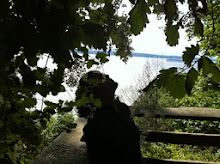So it begins again. A walk in a grassy meadow. A violet by a mossy stone half hidden from the eye*. A handful of pictures. And then hours of poring over field guides and a long world wide web search. First comes resemblance, then a mass of confusion. What's the difference between a harebell and a bluebell? If you had been paying attention you'd know by now that the knapweed is nothing like the melancholy thistle. The Astragalus genus (common name milk-vetch) has about 3000 species. And the Asteraceae group has more than 22750 species spread across 1620 genera and 12 subfamilies. That includes the aster, daisy, marigolds, chrysanthemums, zinnias, dahlias and sunflowers. If that isn't a humbling encounter with biodiversity, then what is? Finally along comes a name and with it an introduction to the fascinating world of what we call 'wildflowers' affording us a tiny glimpse into the other far more enduring and enthralling world wide web. The one where Lucy and a violet by a mossy stone not only share a common ground but also a common fate. Or as Shakespeare wrote, one touch of nature makes the whole world kin*.
Wildflowers in order of appearance: scabious (rare to picture without a butterfly or a moth feasting on its rich nectar), early marsh orchid, mountain buttercup, bladder campion, harebell, hawkweed, Astragalus monspessulanus(?), Cat's ear (with the background blur composed of red clover, white daisy and yellow kidney vetch).
*She Dwelt Among Untrodden Ways by William Wordsworth a poem that instilled a lifelong search for unappreciated beauty epitomized by wildflowers.
** From Troilus and Cressida

























No comments:
Post a Comment